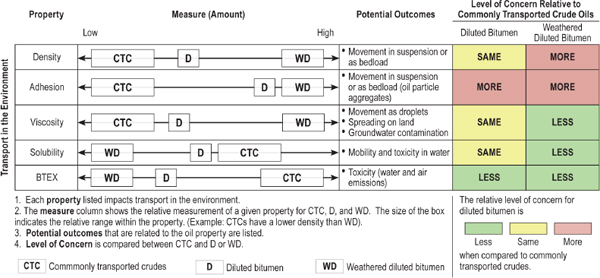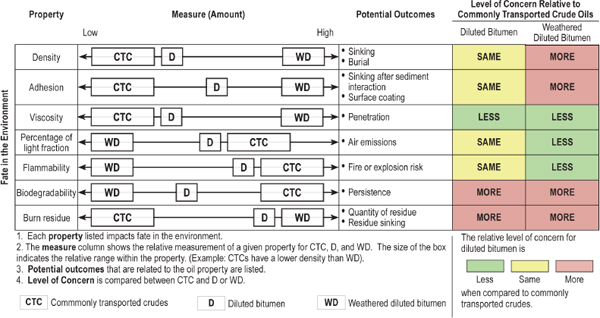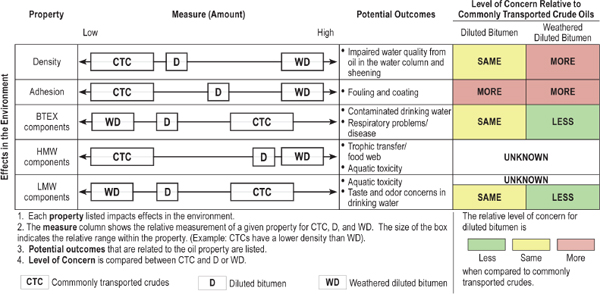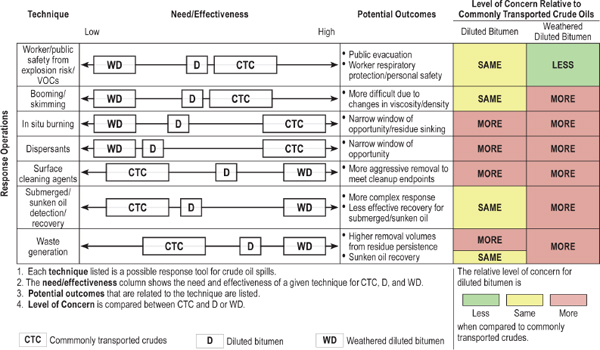5
Comparing Properties Affecting
Transport, Fate, Effects, and Response
The preceding chapters have outlined differences between commonly transported crude oils and diluted bitumen in terms of compositions, properties, and likely fates in the environment. Using a potential spill from a transmission pipeline as a framework, the comparison can be extended to consider how those differences relate to the responses that would be necessary. Three potential products of a spill via transmission pipeline that are analyzed include (i) a spill of crude oil (commonly light or medium crude), (ii) a spill of diluted bitumen, and (iii) the residue produced by weathering of diluted bitumen, a few days after a spill. The third point is important because, relative to a light or medium crude oil, diluted bitumen is likely to produce a heavy residue both more promptly and in greater quantity.
POTENTIAL OUTCOMES AND LEVEL OF CONCERN
Three sets of hazards can be identified. The first relates to the transport or movement of spilled products in the environment. The second relates to the fates of those products (sinking, evaporation, persistence, etc.). The third relates to the effects of those products (impaired water quality, toxicity, air pollution, etc.). For each set of hazards, drawing on information summarized in Chapters 2 and 3, key properties were identified that could be related to the level of concern regarding that hazard. Finally, the levels of concern associated with each of the three products of interest were compared. Overall, this chapter represents an effort to
distill the accumulated information, doing so in ways that are relevant to the regulatory framework.
Environmental hazards related to the release of diluted bitumen, and its eventual conversion to weathered diluted bitumen, are summarized and compared with other commonly transported crude oils in Figure 5-1. In Figure 5-1 the first column lists properties affecting transport, for example, adhesion and solubility. The second column graphically summarizes how commonly transported crude oils (CTC), diluted bitumen (D), and the residue resulting from weathering of diluted bitumen (WD) compare in terms of that property. The second column in the figure shows, for example, the density of commonly transported crude oils is lower than that of diluted bitumen and that the density of weathered diluted bitumen is considerably higher. The third column lists potential outcomes related to each property of interest. For example, density is an important factor in determining whether a product will submerge and move, for example, in a river or stream, in suspension, or as part of the bed load. Finally, the fourth and fifth columns tabulate the level of concern relative to that associated with a commonly transported crude oil. For example, the densities of commonly transported crudes and of diluted bitumen are so similar that the levels of concern regarding the related potential outcomes are approximately equal (noted in Figure 5-1 as “Same”). In contrast, the higher density of weathered diluted bitumen causes an increased level of concern (“More”). Columns 4 and 5 are color-coded, indicating whether a high or low value would exacerbate the risk associated with a potential outcome.
Crude oil that floats on water is transported by different mechanisms than crude oil that submerges, often sorbed onto sediments, and is transported in suspension or in the bed load of streams and rivers. The greater density of weathered bitumen results in a greater level of concern that weathered bitumen will become submerged in an aquatic environment (Chapter 3). Even in the first days of a spill, the greater adhesive properties of diluted bitumen compared to commonly transported crude oils result in a greater level of concern. This concern derives from impacts on wildlife and vegetation and from the associated public reaction, as volunteers mobilize to rescue contaminated wildlife, for example.
The greater level of concern for weathered bitumen also reflects the potential magnitude of the long-term effects of a spill that reaches a water body. Given the known composition of diluted bitumen, a much greater proportion of the material released can be expected to become denser than water and/or adhere to sediments, thereby sinking and entering
the bed load and sediments of riverine, wetland, and coastal environments. Furthermore, once the weathered bitumen becomes incorporated into the bed load, it may be deposited some distance from the initial spill and remobilized in a future storm or flood. Thus, the benefits of being prepared to contain the diluted bitumen early during the response to a spill are substantial.
Very little is known about the risks associated with a subsurface release of diluted bitumen (i.e., into groundwater or a deep water column), particularly in terms of the risks of dissolution of the light, relatively water-soluble monoaromatics such as benzene, toluene, ethyl benzene, and xylenes (BTEX) into groundwater, where loss by volatilization and microbial degradation are likely to be slow.
The other properties noted in Figure 5-1, namely viscosity, solubility, and concentrations of the BTEX compounds, relate to other modes of transport and to toxicity. During the first few days after a spill, while substantial portions of the diluent are likely to remain, the diluted bitumen can be expected to be transported in a manner similar to that for commonly transported crude oil. The spill responses that are standard for crude oils can be applied effectively to diluted bitumen prior to weathering. On the other hand, once sufficient weathering has occurred, there is a lower level of concern that weathered bitumen will be transported by spreading compared to commonly transported crude oils or to diluted bitumen. Lower levels of concern also apply to other outcomes that are particularly important in spills of commonly transported crude oil, such as contamination of groundwater and release of toxic volatile compounds (e.g., BTEX).
Figure 5-2 summarizes estimates of the risks associated with a variety of fates for the spilled material. Those fates, or outcomes, such as sinking, surface coating, and burn residue are listed in the third column of the figure. The effects of density and adhesion on sinking and burial are similar to those on transport noted in Figure 5-1. The viscosity of diluted bitumen, or especially that of its weathered residues, however, is high enough that the risk of penetration in a soil profile is lower than that of a commonly transported crude oil.
While the diluent is retained, concentrations of the very lightest, most volatile, and most flammable hydrocarbons in a diluted bitumen (particularly if the diluent is a gas condensate) may be similar to or less than those of a light or medium crude. Accordingly, the risks associated with spills of diluted bitumen are approximately the same as those for spills of commonly transported crude oils. On the other hand, the weathered
residues resulting from spills of diluted bitumen are less volatile and less flammable than those of commonly transported crude oils.
The presence in diluted bitumen, and particularly in its weathered residues, of large quantities of resins and asphaltenes heightens the level of concern about long-term persistence in the environment. Compared to commonly transported crude oils, a larger proportion of diluted bitumen and its weathered residues have the potential to become retained in sediments or in soils. Additionally, both the greater density and adhesive properties of weathered bitumen contribute to the greater likelihood of such an unfavorable outcome. If partially weathered bitumen becomes buried or entrained in sediments it can be more difficult to delineate and remove. This outcome can lead to a protracted period of exposures to the biota.
For commonly transported crude oils, there is a reasonable prospect that some portion of the oil not collected by cleanup activities will be biologically degraded in the water column or in soil and sediment. Figure 5-2 summarizes estimates of the risks associated with a variety of fates for the spilled material. Those fates, or outcomes, such as sinking, surface coating, and residue after burning, are listed in the third column of the figure. The effects of density and adhesion on sinking and burial are similar to those on transport noted in Figure 5-1.
Another fate issue is the comparison of the effectiveness of oil removal by in situ burning. Studies have shown9c the diluted bitumen has a shorter time window in which burning can be effective and a lower burn efficiency, compared to commonly transported crude oils. Thus, burning could leave a larger amount of residues for removal.
Overall, the level of concern for environmental persistence of a substantial portion of the released material is greater for diluted bitumen and much greater for weathered bitumen
Effects, or outcomes, such as impaired water quality and hazardous air pollution, are considered in Figure 5-3. Density and adhesion again heighten the risks associated with diluted bitumen and especially with its weathered residues. Concentrations of the BTEX compounds in diluents are commonly high enough that related risks associated with diluted bitumen are similar to those with commonly transported crude oils, though the near absence of those compounds in the weathered residues yields a lowered risk.
For commonly transported crude oils, BTEX compounds are generally an immediate concern and this is true to a similar (or lesser) extent for diluted bitumen, which would correspond to the first phase of spill
response. For the weathered bitumen BTEX is much less of a concern. In contrast, the level of concern is reversed for high molecular weight compounds that may be transferred in food webs and present a concern in terms of chronic toxicity. The major concern is the distinct lack of chemical characterization, biodegradation, and targeted toxicity studies for diluted bitumen compared to other commonly transported crude oils.
As discussed in Chapter 4, a central goal of the response strategies for spills of crude oils is to protect human health and avoid or minimize long-term detrimental outcomes in the environment. To further address the statement of task, a comparative approach was used when considering the response to spills of diluted bitumen in relation to spills of commonly transported crude oil. In the comparisons presented in Figure 5-4 illustrates that there are distinctive aspects of effective response techniques to spills of diluted bitumen that need to be addressed in the near term to avoid such an outcome.
The behavior of the light components of any spill in the first few days of an environmental release directly influences two aspects of the response. One immediate aspect of a spill is the potential health hazards to the public and the spill responders posed by volatile organic compounds. The extent of this risk for diluted bitumen products depends upon the diluent used; if condensate is used as a diluent, the level of concern may be comparable to that associated with light crude oil. The need to take appropriate measures, such as evacuation of nearby areas and/or providing appropriate personal protective equipment to the spill responders tasked with containing the spill, provides an added layer of complexity to response. These concerns are represented as being most significant in the first 2 days of the spill response for spills of both commonly transported crude oils and diluted bitumen and become less of a concern for diluted bitumen after weathering has occurred.
Another aspect of the diluent behavior that influences spill response during the first few days is the progressive loss of the diluent by evaporation, which decreases the tendency for diluted bitumen to float and spread on the surface of a receiving water body. This is noteworthy for diluted bitumen because the density of the oil being transported may be that of a medium crude oil, but this can change substantially as weathering occurs to yield a residual material with a density that approaches that of water.
As a result, the initial period when diluted bitumen can be contained and recovered by established response protocols coincides with the period when the exposure risk due to volatiles influences the spill response activities. In particular, the assessment of where and how much diluted bitumen has been spilled may be held back if potentially dangerous levels of volatiles are encountered. As indicated in Figure 5-5, if containment, booming, and/or recovery of a large portion of the spilled diluted bitumen are not achieved during this initial period, a significant portion of the spilled oil may aggregate with particulate matter and become submerged. In contrast, in spills of commonly transported crude oils, the major fraction of the oil will likely continue to float for a longer period and often only a minor fraction may adhere to particulate matter and become submerged. Thus, the rapid loss of diluent inherently presents a distinct immediate challenge in responding to spills of diluted bitumen compared to spills of commonly transported crude oils.
Beyond the challenges presented by the behavior of the diluent, there are other distinctive aspects of the initial spill response for diluted bitumen. One is that use of in situ burning can only be effective for diluted bitumen within the first 24 hours (Figure 5-5). Unlike the outcome for commonly transported crude oils, where up to 99% can be removed by in situ burning over a longer period of time, a much lower percentage is removed upon burning diluted bitumen with the resulting burned residue being highly recalcitrant. Similarly, relative to commonly transported crude oils, there is a much narrower window of opportunity in which chemical dispersants can be applied effectively to spills of diluted bitumen. Based on laboratory and mesocosm studies, the effectiveness of dispersants on diluted bitumen is negligible after 6-12 hours, compared to effective dispersions of 50% to 90% after up to 72 hours for light and medium crude oils. A second distinctive aspect of diluted bitumen is that more oil may sorb onto structures and vegetation due to the increased adhesion described in Chapters 2 and 3. This will present challenges for removal with conventional methods.
If containment is not successful in the initial period of the response to a spill of diluted bitumen, the contrasts with spills of commonly transported crude oils are greatly amplified. As the diluted bitumen weathers, more of the oil may become submerged if the mixing energy is high and particulate matter is available. These products may either be carried downstream or be deposited in sediments when turbulence decreases. Under conditions where commonly transported crude oil may become submerged, in situ biodegradation can be considered when one is evaluating the impacts of the residual oil versus the impacts of intensive removal of the oil. However, biodegradation is less likely to be effective for a submerged and sunken weathered bitumen. The removal of this weathered
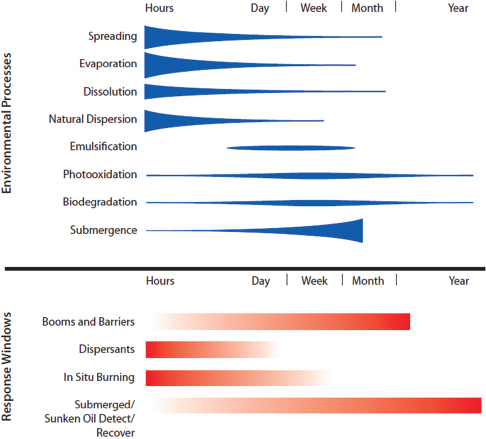
FIGURE 5-5 Time scales of environmental processes affecting spills of diluted bitumen and the windows of time for various response options.
bitumen may involve extensive physical disruption and generate large quantities of waste material and contaminated water to be treated. The environmental and economic benefits of avoiding this outcome are potentially great, but these benefits can only be achieved in the initial few days of the spill response. Thus, recognizing the need for prompt action while the diluent is still present is key to an effective response to a diluted bitumen spill. Based on this comparison of timelines and potential outcomes, there are distinct aspects of effective responses to spills of diluted bitumen in comparison to effective responses to spills of commonly transported crude oils.
The prospect of a release of crude oil into the environment through a pipeline failure inherently raises a number of concerns. These concerns include not only minimizing a number of possible long-term environmental impacts but also protecting the safety of responders and the public during and after the spill response. When all risks are considered systematically, there must be a greater level of concern associated with spills of diluted bitumen compared to spills of commonly transported crude oils.
In the context of fate, transport, and effects, the properties of diluted bitumen and weathered diluted bitumen that consistently result in greater levels of concern involve the higher density of the bitumen. The environmental outcome that should be most vigorously avoided in a spill response is the weathering of spilled diluted bitumen into heavy, sticky, sediment-laden residue that cannot readily be recovered, which requires dredging and disposal of large quantities of contaminated sediment and water, and which will not degrade if left in the environment. This weathering process begins rapidly following a release and can change the behavior of diluted bitumen in a matter of days. At the same time, the level of concern for responders and public safety associated with toxic and potentially explosive volatiles in the diluent fraction is similar as for commonly transported crude oils as these concerns are associated with properties of the diluents used.
The oil and pipeline industries and the response community have developed approaches for addressing releases of crude oil that are based on accumulated experience in responding to the diversity of spills that have occurred, as well as knowledge of the general properties of crude oil. This experience is predominantly based on spills of commonly transported crude oils that can be expected to float for some time. Given these greater levels of concern, spills of diluted bitumen should entail special immediate actions in response, for example, that the properties of diluted bitumen and weathered bitumen put such spills in a class by themselves.













